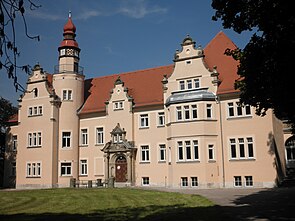Schwerstedt (Am Ettersberg)
|
Schwerstedt
Rural community Am Ettersberg
Coordinates: 51 ° 4 ′ 20 ″ N , 11 ° 17 ′ 24 ″ E
|
|
|---|---|
| Height : | 204 m |
| Area : | 6.81 km² |
| Residents : | 329 (December 31, 2017) |
| Population density : | 48 inhabitants / km² |
| Incorporation : | 1st January 2019 |
| Postal code : | 99439 |
| Area code : | 036452 |
Schwerstedt is a district of the rural community Am Ettersberg in the Weimarer Land district .
geography
Schwerstedt is located in the Thuringian Basin about ten kilometers north of Weimar at an altitude of about 200 meters. The surroundings of the place are mainly used for agriculture. In the north of the village, the Schwerstedt reservoir , is a retention basin that is fed from the Lache stream and is used for flood protection, irrigation and recreation. During the damming in the GDR era, part of the palace park was lost.
history

For the first time Schwerstedt was mentioned as Suegerstete in a list of properties of the Reichsabtei Hersfeld before 802. This makes Schwerstedt one of the oldest places in the district. The place name can be derived from the Old High German Sweigari (= swineherd).
The Lords of Schwerstedt were mentioned in 1247 and 1302. They were perhaps the administrators of the moated castle , which was located in the area of the later manor in the northwest of the village. Some stable buildings and preserved walls probably go back to the fortress. The castle men protected the Via Regia as well as the country and its people .
The majority of the population subsisted on agriculture. There is evidence of woad cultivation in the 16th century . At the end of the 19th century, beekeeping made the place famous. A brewery and later also a distillery belonged to the local manor. The place was destroyed in the Thirty Years War . The plague also broke out several times in Schwerstedt.
In 1945, under the Soviet occupation , the von Helldorff family , who owned the castle , the castle park and the manor with around 500 hectares, were expropriated without compensation. The estate manager was picked up by the NKVD and did not return. The von Helldorff family went to West Germany . After the reunification , a daughter of the last owner of the castle and estate came back to Schwerstedt, took up residence in the "villa" and bought back part of the estate.
During the GDR era, the agricultural school for the Weimar-Land district was located in Schwerstedt and housed in the old castle. Today the facility is used as a state vocational school for agricultural professions in Thuringia. Around 80 employees train around 1800 students and apprentices a year.
On January 1, 2019, the municipality of Schwerstedt was merged with other municipalities of the administrative community of Northern Weimar to form the rural municipality of Am Ettersberg .
politics
The municipal council consisted of six members:
- Fire Brigade Association Schwerstedt e. V .: 5 seats
- CDU : 1 seat
(As of: local election on June 7, 2009.)
Attractions
The following objects are listed according to the monuments list of the district Weimarer Land:
- Church with churchyard (trees, no more graves). The pulpit wall and the baptismal font in the church are dated to 1751–1775.
- former school, No. 38
- former castle / manor house, No. 90 ( location → )
Furthermore, buildings no. 89, 90 and 90b and the park of the former estate are protected as a monument ensemble.
At the entrance to the cemetery there is a memorial for the 14 Schwerstedts who fell in World War I , including Major General Wolf von Helldorff . Above the name there is an inscription: "Shielding our homeland fell in the World War".
The Laura cycle path leads through Schwerstedt .
Personalities
- Hans Ranke (1888–1941), teacher and local history researcher
Web links
Individual evidence
- ↑ Michael Köhler: Thuringian castles and fortified prehistoric and early historical living spaces. Jenzig-Verlag Köhler, Jena 2001, ISBN 3-910141-43-9 , p. 231.
